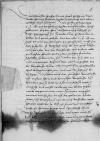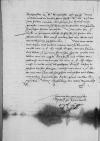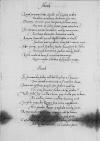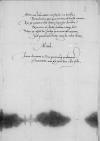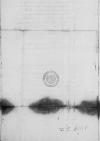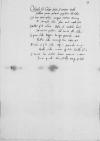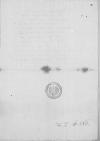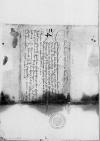Wir haben gestrigs tags E(wer) f(urstlichen) D(urchlauch)t und des hochwirdigsten, durchlauchten, hochgebornen fursten, / hern ⌊Wilhelms⌋, ertzbischoff zu ⌊Riege⌋, / marggraff zu ⌊Brandenburg⌋ etc. ⌊⌋ erhalten und gerne gelesen. / Wie uns aber E(wer) f(urstliche) D(urchlauch)t anzeigt dis mal von zeitungen, / die gewis sein, / nicht sonders zu haben, / ist dergestalt auch bei uns auch. / Nichts wenigers sein uns von ⌊koniglicher m(ajeste)t⌋, unserm allergnedigisten herren, / und andern guthen freunden ⌊⌋ zukammen, / zur ⌊Wilne⌋ den XII dits monats ausgangen, / dorinne uns wirt angezeigt, das die ⌊konigliche m(ajeste)ten⌋ alle semptlich in guether, (: Got hab lob, :) gesuntheit sein, und mit der jagt sich belustigen, / doneben auch, das zwuschen ⌊koniglicher m(ajeste)t⌋, unserm hern, / und ⌊romischer koniglicher m(ajeste)t⌋ besondere grosse liebe und freuntschaff teglich wachsse und nichts widdrigs von beiden teylen werde vorgenommen, / was ⌊Hungern⌋ angehet. / Wiewol etliche sein, die uff des gebornen erben seiten sich beweisen, / so wil dennoch derhalben unser her / von liebe, die ir m(ajeste)t zu fried und einigkeyt tregt, / zu keinem kriege und christlichs blutsvorgissen sich lassen einfuren, / derwegen auch zu ro(mische)r ko(nigliche)r m(ajeste)t willen gneigt, / woraus gevolget, / das furbaskonig [...] stain⌈[...][...] stain⌉, unser herr, / alweg iren stain⌈[ren]ren stain⌉  GStA PK, HBA, C. 1, No. 704, f. 1v botschaffter an ro(mische)r koniglicher m(ajeste)t hoffe / unnd widderumb an unsers hern hoffe r(omische)r ko(nigliche)r m(ajeste)t den iren halten werden, / das zuvor im brauch nicht gewesen, / woraus sich besonder vortrauen und glauben zwuschen beiden erweiset. /
GStA PK, HBA, C. 1, No. 704, f. 1v botschaffter an ro(mische)r koniglicher m(ajeste)t hoffe / unnd widderumb an unsers hern hoffe r(omische)r ko(nigliche)r m(ajeste)t den iren halten werden, / das zuvor im brauch nicht gewesen, / woraus sich besonder vortrauen und glauben zwuschen beiden erweiset. /
Das aber der h(er) ⌊Laski⌋ in ⌊Hungern⌋ etliche schlosser sol haben eingenommen, / kan nicht anders, dan von beider teil vorwilligung gescheen sein. /
Was uns weiter von diesen und andern ortern wirt zukommen, wolle wir E(wer) f(urstlichen) D(urchlauch)t nicht bergen, / die wir freuntlich bitten, / so vil uns zu wissen zymet, / wolde mitteilen, was die negste botschafft aus ⌊Litten⌋ vorgebracht / und wormitte die von E(wer) f(urstlichen) D(urchlauch)t abgericht. / Wolde auch beigelegten brieff dohin er gehort lassen fertigen, / welchs wir umb E(wer) f(urstliche) D(urchlauch)t, der wir von Gote alle seligheit wunschen und bitten, / mit unsern freuntlichen dinsten gerne wollen beschulden. /
 GStA PK, HBA, C. 1, No. 704, f. 5r
GStA PK, HBA, C. 1, No. 704, f. 5r
Vor das ⌊⌋ uns zugeschickt, / thue wir E(wer) f(urstlichen) D(urchlauch)t freuntlich dancken, / wiewol wir es vor etlichen wochen gehabt / und dorauff ⌊⌋, wie aus beigelegter zedell zuvornehmen. / Es were nicht gut, das kein glaub / und nemlich zwuschen solchen heupten sein solte etc.
 GStA PK, HBA, C. 1, No. 704, f. 5v
GStA PK, HBA, C. 1, No. 704, f. 5v
Auch bitten wir antwort uff unser und unsers ⌊w(irdigen) capitels⌋ schreiben / von wegen des unleidlichen baut der mulhen bis uff unser seitten und boden erstreckt, / das der wurd / ane unlust, der doraus volgen mochte, / abgethan. /
 GStA PK, HBA, C. 1, No. 704, f. 6v
GStA PK, HBA, C. 1, No. 704, f. 6v  GStA PK, HBA, C. 1, No. 704, f. 1r
GStA PK, HBA, C. 1, No. 704, f. 1r  GStA PK, HBA, C. 1, No. 704, f. 1v botschaffter an ro(mische)r koniglicher m(ajeste)t hoffe / unnd widderumb an unsers hern hoffe r(omische)r ko(nigliche)r m(ajeste)t den iren halten werden, / das zuvor im brauch nicht gewesen, / woraus sich besonder vortrauen und glauben zwuschen beiden erweiset. /
GStA PK, HBA, C. 1, No. 704, f. 1v botschaffter an ro(mische)r koniglicher m(ajeste)t hoffe / unnd widderumb an unsers hern hoffe r(omische)r ko(nigliche)r m(ajeste)t den iren halten werden, / das zuvor im brauch nicht gewesen, / woraus sich besonder vortrauen und glauben zwuschen beiden erweiset. /
 GStA PK, HBA, C. 1, No. 704, f. 5r
GStA PK, HBA, C. 1, No. 704, f. 5r  GStA PK, HBA, C. 1, No. 704, f. 5v
GStA PK, HBA, C. 1, No. 704, f. 5v 